Apps
Auto Added by WPeMatico
Auto Added by WPeMatico
Front is launching a major revamp today. And it starts with a brand new design. Front is now powered by React for the web and desktop app, which should make it easier to add new features down the road.
Front hasn’t pivoted to become something else. At heart, it remains a multiplayer email client. You can share generic email addresses with your coworkers, such as sales@yourcompany or jobs@yourcompany. You can then assign emails, comment before replying and integrate your CRM with your email threads.
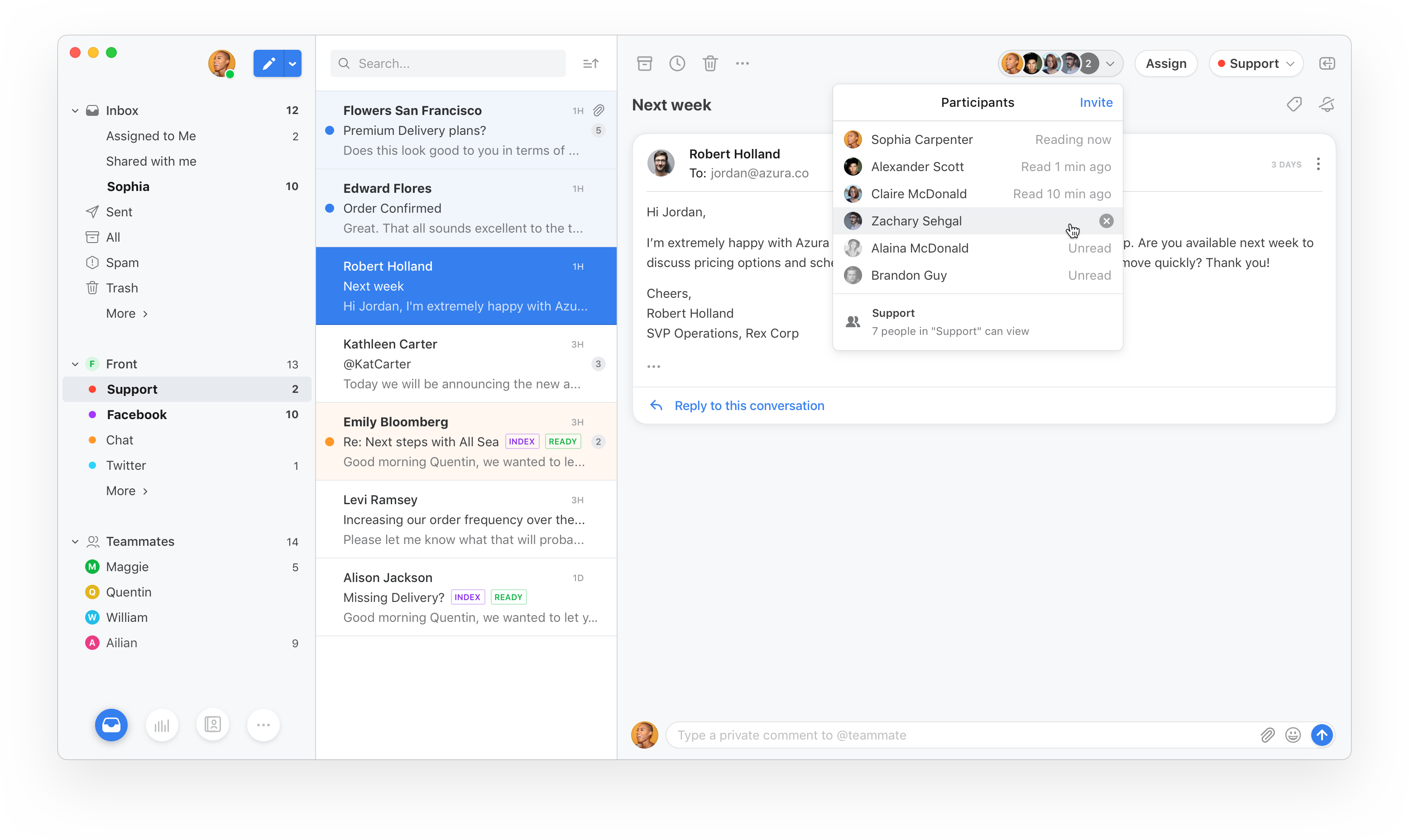
But the company is also adding a bunch of new features. The most interesting one is the ability to start a thread with your team without having to send an email first. If a client sends you an email, you can comment on the thread and mention your coworkers just like on a Facebook post.
Many companies already use emails for internal communications. So they started using Front to talk to their coworkers. Before today, you had to send an original email and then people could comment on it. Now, you can just create a post by giving it a title and jumping to the comment section. It’s much more straightforward.
“We aren’t planning for all internal conversations to move to Front, but a lot of them very well could. A tool like Slack is often used for questions that don’t require the immediate response that Slack demands,” co-founder and CEO Mathilde Collin told me. “By bringing these messages into Front, we aim to reduce disruptions and help people stay focused.”
In other words, a Slack message feels like a virtual tap on the shoulder. You have to interrupt what you’re doing to take a minute and answer. Front can be used for asynchronous conversations and things that don’t need an immediate response. That’s why you can now also send Slack messages to Front so that you can deal with them in Front.
With this update, Front is making sharing more granular. Front isn’t just about shared addresses. You can assign your personal emails to a coworker — this is much more efficient than forwarding an email. Now, you can easily see who can read and interact with an email thread at the top of the email view.
If somebody sends an email to Sarah and Sam, they’ll both have a copy of this email in their personal inboxes. If Sarah and Sam start commenting and @-mentioning people, Front will now merge the threads.
As a user, you get a unified inbox with all your personal emails, emails that were assigned to you and messages assigned to your team inbox.
Finally, Front has improved its smart filtering system. You can now create more flexible rules. For instance, if an email matches some or all criteria, Front can assign an email to a team or a person, send an automated reply, trigger another rule and more.
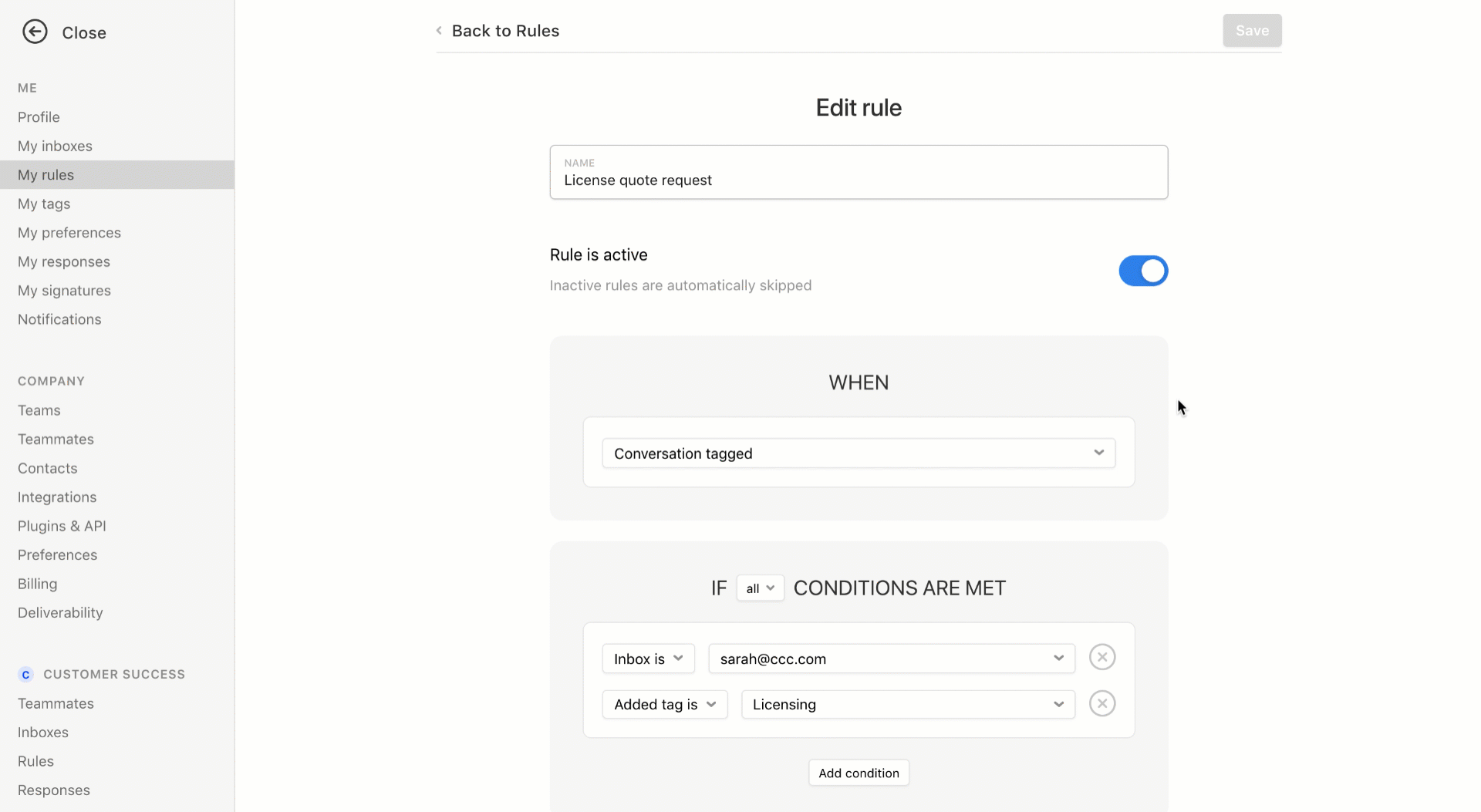
The new version of Front will be available later this month. Once again, Front remains focused on its core mission — making work conversations more efficient and more flexible. The company doesn’t try to reinvent the wheel and still relies heavily on emails.
Many people (myself included) say that email is too often a waste of time. Dealing with emails doesn’t necessarily mean getting work done. Front wants to remove all the pains of this messaging protocol so that you can focus on the content of the messages.
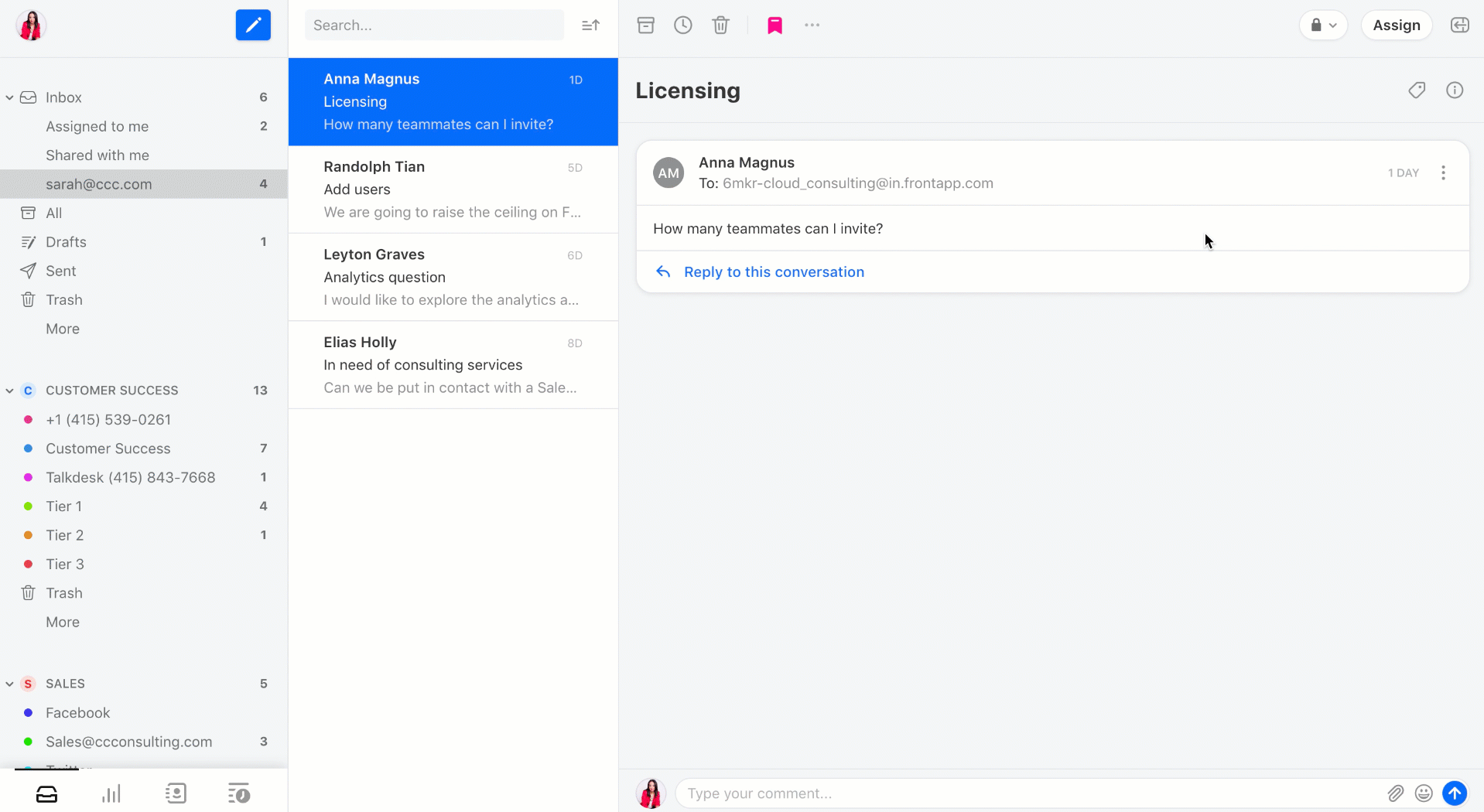
Powered by WPeMatico
Parker Conrad likes to save time, even though it’s gotten him in trouble. The former CEO of Zenefits was pushed out of the $4.5 billion human resources startup because he built a hack that let him and employees get faster insurance certifications. But 2.5 years later, he’s back to take the busy work out of staff onboarding as well as clumsy IT services like single sign-on to enterprise apps. Today his startup Rippling launches its combined employee management system, which Conrad calls a much larger endeavor than the minimum viable product it announced while in Y Combinator’s accelerator 18 months ago.
“It’s not an HR system. It’s a level below that,” Conrad tells me. “It’s this unholy, crazy mashup of three different things.” First, it handles payroll, benefits, taxes and PTO across all 50 states. “Except Syria and North Korea, you can pay anyone in the world with Rippling,” Conrad claims. That makes it a competitor with Gusto… and Zenefits.
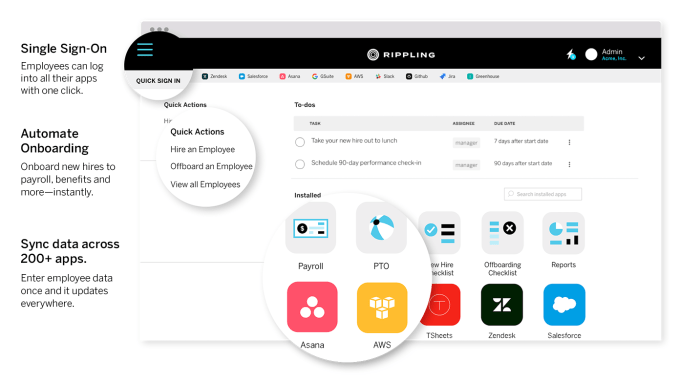
Second, it’s a replacement for Okta, Duo and other enterprise single-sign on security apps that authenticate staffers across partnered apps. Rippling bookmarklets make it easy to auth into over 250 workplace apps, like Gmail, Slack, Dropbox, Asana, Trello, AWS, Salesforce, GitHub and more. When an employee is hired or changes teams, a single modification to their role in Rippling automatically changes all the permissions of what they can access.
And third, it handles computer endpoint security like Jamf. When an employee is hired, Rippling can instantly ship them a computer with all the right software installed and the hard drive encrypted, or have staffers add the Rippling agent that enforces the company’s security standards. The system is designed so there’s no need for an expert IT department to manage it.
“Distributed, fragmented systems of record for employee data are secretly the cause of almost all the annoying administrative work of running a company,” Conrad explains. “If you could build this system that ties all of it together, you could eliminate all this crap work.” That’s Rippling. It’s opening up to all potential clients today, charging them a combined subscription or à la carte fees for any of the three wings of the product.
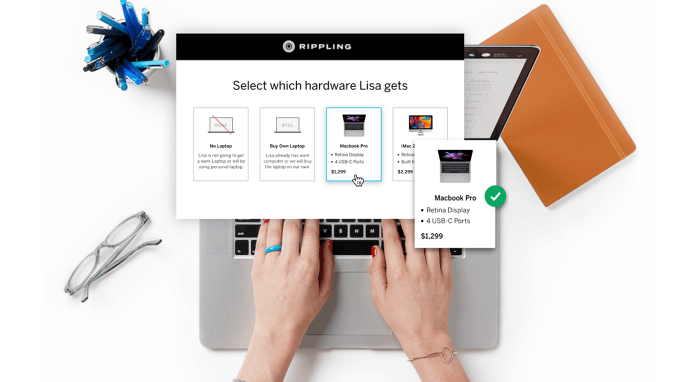
Conrad refused to say how much Rippling has raised total, citing the enhanced scrutiny Zenefits’ raises drew. But he says a Wall Street Journal report that Rippling had raised $7 million was inaccurate. “We haven’t raised any priced VC rounds. Just a bunch of seed money. We raised from Initialized Capital, almost all the early seed investors at Zenefits and a lot of individuals.” He cited Y Combinator, YC Growth Fund, YC’s founder Jessica Livingston and president Sam Altman, other YC partners, as well as DFJ and SV Angel.
“Because we were able to raise a bunch of money and court great engineers . . . we were able to spend a lot of time building this fundamental technology,” Conrad tells me. Rippling has about 50 team members now, with about 40 of them being engineers, highlighting just how thoroughly Conrad wants to eradicate manual work about work, starting with his own startup.
The CEO refused to discuss details of exactly what went down at Zenefits and whether he thought his ejection was fair. He was accused of allowing Zenefits’ insurance brokers to sell in states where they weren’t licensed, and giving some employees a macro that let them more quickly pass the online insurance certification exam. Conrad ended up paying about $534,000 in SEC fines. Zenefits laid off 430 employees, or 45 percent of its staff, and moved to selling software to small-to-medium sized businesses through a network of insurance brokers.
But when asked what he’d learned from Zenefits, Conrad looked past those troubles and instead recalled that “one of the mistakes that we made was that we did a lot stuff manually behind the scenes. When you scale up, there are these manual processes, and it’s really hard to come back later when it’s a big hard complicated thing and replace it with technology. You get upside down on margins. If you start at the beginning and never let the manual processes creep in . . . it sort of works.”

Perhaps it was trying to cut corners that got Conrad into the Zenefits mess, but now that same intention has inspired Rippling’s goal of eliminating HR and IT drudgery with an all-in-one tool.
“I think I’m someone who feels the pain of that kind of stuff particularly strongly. So that’s always been a real irritant to me, and I saw this problem. The conventional wisdom is ‘don’t build something like this, start with something much smaller,’ ” Conrad concludes. “But I knew if I didn’t do this, that no one else was gong to do it and I really wanted this system to exist. This is a company that’s all about annoying stuff and making that fucking annoying stuff go away.”
Powered by WPeMatico
As zero-commission stock trading app Robinhood starts preparing to IPO, an engineering investment two years in the making could accelerate its quest for profitability. Most stock broker services have to pay an external clearing house to reconcile trades between buyers and sellers. Now with 6 million accounts up from 4 million just 5 months ago, that added up to a huge cost for Robinhood since it doesn’t demand a trading fee like the $7 to $10 that incumbent competitors E*Trade and Scottrade charge. Relying on outside clearing also introduced bottlenecks around its innovation and user sign ups, limiting onboarding to business hours.
But today Robinhood will start migrating accounts to its new in-house clearing service over the next few months. That will save it from paying clearing fees on stock, option, ETF and cryptocurrency trades. In turn, Robinhood is eliminating or reducing some of its edge case fees: $10 broker assisted trades, $10 restricted accounts, $50 voluntary corporate actions and $30 worthless securities processing will all now be free. Robinhood is meanwhile cutting its margin on fees passed on by banks or FedEx, so ACH reversal fees will drop from $30 to $9, overnight check delivery from $35 to $20 and overnight mail from $35 to $20.
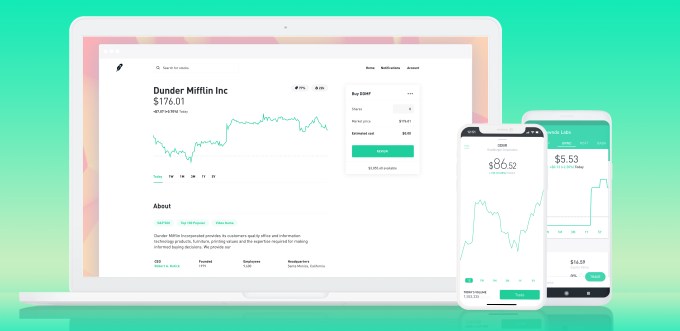
“What’s really interesting is that this is the only clearing system built from scratch on modern technology in at least the last decade,” Robinhood co-founder and co-CEO Vlad Tenev tells me. Most clearing services ran mainframes and terminal-based UIs that aren’t built for the pace of startup innovation. Going in-house “allows us to vertically integrate our business so we won’t have to depend on third-parties for foundational aspects. It’s a huge investment in the future of Robinhood that will massively impact our customers and their experience, but also help us out on building the kind of business we want to build.”
There’s a ton of pressure on Robinhood right now since it’s raised $539 million to date, including a $363 million Series D in May at a jaw-dropping $5.6 billion valuation just a year after raising at $1.3 billion. Currently Robinhood earns revenue from interest on money kept in Robinhood accounts, selling order flow to exchanges that want more liquidity, and its Robinhood Gold subscriptions, where users pay $10 to $200 per month to borrow $2,000 to $50,000 in credit to trade on margin. Last month at TechCrunch Disrupt, Robinhood’s other co-CEO Baiju Bhatt told me the startup is now actively working to hire a CFO to get its business ready to IPO.
Whoever that CFO is will have an easier job thanks to Christine Hall, Robinhood’s Product Lead for Clearing. After stints at Google and Udacity, she was hired two years to navigate the regulatory and engineering challenges of spinning up Robinhood Clearing. She explains that “Clearing is just a fancy word for making sure that when the user places a trade, the price and number of shares matches what the other side wants to give away. In the less than 1 percent chance of error, the clearing firm makes sure everyone is on the same page prior to settlement.

Robinhood Clearing Product Lead Christine Hall
Forming the Robinhood Securities entity, Hall scored the startup the green light from FINRA, the DTCC and the OCC. She also recruited Chuck Tennant, who’d previously run clearing firms and would grow a 70-person team for the project at Robinhood’s Orlando office. They allow Robinhood to clear, settle (exchanging the dollars and shares) and ensure custody (keeping records of asset movements) of trades.
“It gives us massive cost savings, but since we’re no longer depending on a third-party, we basically control our destiny,” Tenev says. No more waiting for clearing houses to adapt to its new products. And no more waiting the whole weekend for account approval as Robinhood can now approve accounts 24/7. These little improvements are critical to Robinhood staying ahead of the pack of big banks like Charles Schwab that are lowering their fees to compete, as well as other startups offering mobile trading. The launch could also blossom into a whole new business for Robinhood if it’s willing to take on clearing for other brokers, including fintech apps like Titan.
Clearing comes with additional risk. Regulatory scrutiny is high, and the more Robinhood brings in-house, the more security work it must do. A breach could break the brand of user trust it’s been building. Yet if successful, the launch equips Robinhood for an ambitious future beyond playing the markets. “The mission of the company has expanded a lot. It used to be all about stock trading. But if you look at Robinhood five years from now, it’s about being best-in-class for all of our customers’ financial needs,” Tenev concludes. “You should be able to get everything from Robinhood that you could get from walking into your local bank.” That’s a vision worthy of the startup’s epic valuation.
Powered by WPeMatico
Google has lodged its legal appeal against the European Commission’s €4.34 billion (~$5BN) antitrust ruling against its Android mobile OS, according to Reuters — the first step in a process that could keep its lawyers busy for years to come.
“We have now filed our appeal of the EC’s Android decision at the General Court of the EU,” it told the news agency, via email.
We’ve reached out to Google for comment on the appeals process.
Rulings made by the EU’s General Court in Luxembourg can be appealed to the top court, the Court of Justice of the European Union, but only on points of law.
Europe’s competition commissioner, Margrethe Vestager, announced the record-breaking antitrust penalty for Android in July, following more than two years of investigation of the company’s practices around its smartphone operating system.
Vestager said Google had abused the regional dominance of its smartphone platform by requiring that manufacturers pre-install other Google apps as a condition for being able to license the Play Store.
She also found the company had made payments to some manufacturers and mobile network operators in exchange for them exclusively pre-installing Google Search on their devices, and used Google Play licensing to prevent manufacturers from selling devices based on Android forks — which would not have to include Google services and, in Vestager’s view, “could have provided a platform for rival search engines as well as other app developers to thrive”.
Google rejected the Commission’s findings and said it would appeal.
In a blog post at the time, Google CEO Sundar Pichai argued the contrary — claiming the Android ecosystem has “created more choice, not less” for consumers, and saying the Commission ruling “ignores the new breadth of choice and clear evidence about how people use their phones today”.
According to Reuters the company reiterated its earlier arguments in reference to the appeal.
A spokesperson for the EC told us simply: “The Commission will defend its decision in Court.”
Powered by WPeMatico
Google today announced that its Pixel phones will soon get support for Smart Compose in Gmail. Smart Compose automatically finishes your sentences for you as you type, based on what Google knows about how you and others write similar sentences. Smart Compose can also auto-complete addresses for you.
Google first launched this feature with its redesigned Gmail for the web, but it’s now bringing this to mobile, too. On mobile, of course, a feature like this is even more interesting since typing on mobile is obviously harder. Google says that on the web, Smart Compose is already saving people a billion characters of typing per week.
It’s interesting that Google is launching this feature first on its Pixel phones. Maybe that’s because those phones also feature Google’s own AI chip.
In my own experience, Smart Compose is great when it works. Too often, it still doesn’t, but the good thing is that you can always ignore it and go your merry way without Smart Compose’s suggestions getting in your way.
Google did not say when this feature would launch, but chances are it’ll go live in the next few days or weeks.
Powered by WPeMatico
“I’ve always believed the web is for everyone,” wrote Tim Berners-Lee, the well-known (and knighted) creator of the World Wide Web.
“The web has evolved into an engine of inequity and division; swayed by powerful forces who use it for their own agendas,” he added. “Today, I believe we’ve reached a critical tipping point, and that powerful change for the better is possible — and necessary.”
Late last month, he published the above in a blog post announcing inrupt, a startup that would finally execute on his vision for the information superhighway he built nearly 30 years ago. Backed with an undisclosed amount of funding from Glasswing Ventures, the startup is emerging from stealth today with a plan to decentralize the web and restore power to the people rather than the companies that have exploited user trust for their own financial gains.
The timing couldn’t be better. The last year has been plagued with scandals, from Cambridge Analytica, a data analysis firm that used Facebook data to target voters for President Donald Trump’s presidential campaign, to most recently a data-exposing hack on Google+ that relinquished the private information of hundreds of thousands of unsuspecting users.
Internet privacy and security are hot-button issues, to say the least. Users are rapidly losing trust in the companies that became institutions in the digital age — and they’re demanding solutions.
The race to restore control of data and the web at large has begun; inrupt is looking to the finish line.
Berners-Lee is a British engineer and professor of computer science who famously gave away the web, which allows anyone with a computer to access the internet, for free.
For the past few years, he’s been quietly working on a project called Solid with a small team at the Massachusetts Institute of Technology. Solid is an open-source project built on the existing web meant to give people control over their own data. Using Solid, users can keep their data wherever they choose, rather than being forced to store it on centralized servers.
The world we’ve created on the web [is] not the right one. — John Bruce, co-founder of inrupt.
Despite its populist ambitions, Solid had failed to garner the momentum necessary to truly disrupt the web.
Berners-Lee realized Solid needed commercial backing, a real business behind it to earn the interests of open-source developers who have to build decentralized apps on the Solid platform for it to be useful.
Thus, inrupt was born. Berners-Lee tapped John Bruce, a fellow British engineer and serial entrepreneur, to lead the company as its chief executive officer. Most recently, Bruce co-founded Resilient, an incident response platform later acquired by IBM. Before that, he was the chairman and CEO of Quickcomm and the vice president of Symantec.
Bruce resigned from IBM in April to focus on inrupt full time.
“The world we’ve created on the web [is] not the right one,” Bruce told TechCrunch. “Maybe, just maybe, we can put it in the place it was originally intended to be.”
“Inrupt’s mission, at this point, is to bring resources, process and skills to galvanize the open-source effort that Tim was leading out of MIT to help [Solid] become, truly, a force to be reckoned with,” he added. “We are at the stage of the new web that Tim was at when he first started the World Wide Web.”
Bruce says that since Berners-Lee announced inrupt in late September, open-source developers have poured into the Solid platform in droves.
Now, the pair are gearing up to raise another round of funding, hire, expand the Solid platform and work on a digital assistant tool called Charlie, which the company describes as a “decentralized version of Alexa.”
For Berners-Lee, inrupt is Act II of a much larger story. For Bruce, it’s the opportunity to work with a legend.
“This is a man that understands the web truly better than anyone else on the planet,” Bruce said. “And the wheels of innovation have really just started to turn.”
Powered by WPeMatico
SoundCloud moves painfully slow for a tech company, and no one feels that pain more than musicians who are popular on the site but don’t get paid. 10 years since SoundCloud first launched, and four years since it opened an invite-only program allowing just the very biggest artists to earn a cut of the ad and premium subscription revenue generated by their listeners, SoundCloud is rolling out monetization.
Now, musicians 18 and up who pay SoundCloud $8 to $16 per month for hosting, get over 5000 streams per month, and only publish original music with no copyright strikes against them can join the SoundCloud Premier program. They’ll get paid a revenue share directly each month that SoundCloud claims “meets or beats any other streaming service”. However, the company failed to respond to TechCrunch’s inquiries about how much artists would earn per 1000 ad-supported or premium subscription listener streams, or how many streams would earn them a dollar.
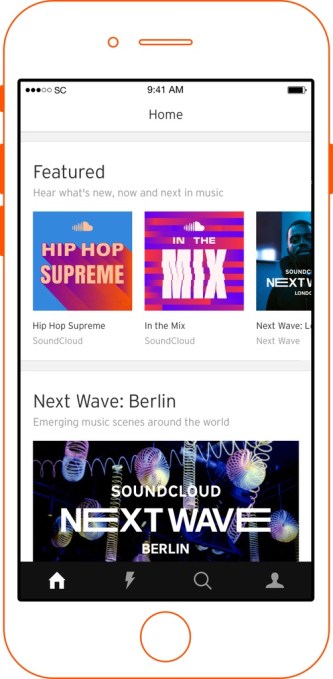 Beyond payouts, Premier members can post new tracks instantly without having to wait to be discoverable or monetizable, they’ll get real-time feedback from fans, and extra discovery opportunities from SoundCloud. The company hopes monetization will lure more creators to join the 20 million on the platform, get them to promote their presence to drive listens, and imbue the site with exclusive artist-uploaded content that attracts listeners.
Beyond payouts, Premier members can post new tracks instantly without having to wait to be discoverable or monetizable, they’ll get real-time feedback from fans, and extra discovery opportunities from SoundCloud. The company hopes monetization will lure more creators to join the 20 million on the platform, get them to promote their presence to drive listens, and imbue the site with exclusive artist-uploaded content that attracts listeners.
It’s been a year since SoundCloud raised an $170 million emergency funding round to save itself from going under after it was forced to lay off 40 percent of its staff. That deal arranged by Kerry Trainor saw him become CEO and the previous co-founder and CEO Alex Ljung step aside. With underground rap that had percolated on SoundCloud for years suddenly reaching the mainstream, the startup seemed to have momentum.
The problem is the slow speed of progress at SoundCloud has allowed competitors with monetization baked in to catch up to its formerly unique offering. YouTube Music’s launch in June 2018 combined premium major label catalogues with user uploaded tracks in a cohesive streaming service. And last month, Spotify began allowing indie artists to upload their music directly to the platform. Meanwhile, licensing distribution services like Dubset are making it legal for big streaming apps to host remixes and DJ sets. Together, these make more of the rarities, live versions, and hour-long club gigs that used to only be on SoundCloud available elsewhere.
The delays seem in part related to the fact that SoundCloud wants to be Spotify as well as SoundCloud. It’s refused to back down from its late entry into the premium streaming market with its $9.99 per month SoundCloud Go+ subscription. As I previously recommended, “to fix SoundCloud, it must become the anti-Spotify” by ruthlessly focusing on its differentiated offering in artist-uploaded music. Instead, another year has passed with only a light revamping of SoundCloud’s homescreen and some more personalized playlists to show for it.
SoundCloud proudly announced it had reached $100 million in revenue in 2017, and exceeded its financial and user growth targets. But filings reveal it lost over $90 million in 2016 and it was previously projected to not become profitable until 2020. That begs the question of whether SoundCloud will have to raise again, or might once again open itself to acquisitions. With Apple, Google, Amazon, and Spotify all in fierce competition for the future of streaming, any of them might be willing to pay up for music that fans can’t easily find elsewhere.
Powered by WPeMatico
Eager to change the conversation from their years-long exposure of user data via Google+ to the bright, shining future the company is providing, Google has announced some changes to the way permissions are approved for Android apps. The new process will be slower, more deliberate and hopefully secure.
The changes are part of “Project Strobe,” a “root-and-branch review of third-party developer access to Google account and Android device data and our philosophy around apps’ data access.” Essentially they decided it was time to update the complex and likely not entirely cohesive set of rules and practices around those third-party developers and API access.
One of those roots (or perhaps branches) was the bug discovered inside Google+, which theoretically (the company can’t tell if it was abused or not) exposed non-public profile data to apps that should have received only a user’s public profile. This, combined with the fact that Google+ never really justified its own existence in the first place, led to the service essentially being shut down. “The consumer version of Google+ currently has low usage and engagement,” Google admitted. “90 percent of Google+ user sessions are less than five seconds.”
But the team doing the review has plenty of other suggestions to improve the process of informed consent to sharing data with third parties.
The first change is the most user-facing. When an application wants to access your Google account data — say your Gmail, Calendar and Drive contents for a third-party productivity app — you’ll have to approve each one of those separately. You’ll also have the opportunity to deny access to one or more of those requests, so if you never plan on using the Drive functionality, you can just nix it and the app will never get that permission.
These permissions can also be delayed and gated behind the actions that require them. For instance, if this theoretical app wanted to give you the opportunity to take a picture to add to an email, it wouldn’t have to ask up front when you download it. Instead, when you tap the option to attach a picture, it would ask permission to access the camera then and there. Google went into a little more detail on this in a post on its developer blog.
Notably there is only the option to “deny” or “allow,” but no “deny this time” or “allow this time,” which I find to be useful when you’re not totally on board with the permission in question. You can always revert the setting manually, but it’s nice to have the option to say “okay, just this once, strange app.”
The changes will start rolling out this month, so don’t be surprised if things look a little different next time you download a game or update an app.
The second and third changes have to do with limiting which data from your Gmail and messaging can be accessed by apps, and which apps can be granted access in the first place.
Specifically, Google is restricting access to these sensitive data troves to apps “directly enhancing email functionality” for Gmail and your default calling and messaging apps for call logs and SMS data.
There are some edge cases where this might be annoying to power users; some have more than one messaging app that falls back to SMS or integrates SMS replies, and this might require those apps to take a new approach. And apps that want access to these things may have trouble convincing Google’s review authorities that they qualify.
Developers also will need to review and agree to a new set of rules governing what Gmail data can be used, how they can use it and the measures they must have in place to protect it. For example, apps are not allowed to “transfer or sell the data for other purposes such as targeting ads, market research, email campaign tracking, and other unrelated purposes.” That probably puts a few business models out of the running.
Apps looking to handle Gmail data will also have to submit a report detailing “application penetration testing, external network penetration testing, account deletion verification, reviews of incident response plans, vulnerability disclosure programs, and information security policies.” No fly-by-night operations permitted, clearly.
There also will be additional scrutiny on what permissions developers ask for to make sure it matches up with what their app requires. If you ask for Contacts access but don’t actually use it for anything, you’ll be asked to remove that, as it only increases risk.
These various new requirements will go into effect next year, with application review (a multi-week process) starting on January 9; tardy developers will see their apps stop working at the end of March if they don’t comply.
The relatively short timeline here suggests that some apps may in fact shut down temporarily or permanently due to the rigors of the review process. Don’t be surprised if early next year you get an update saying service may be interrupted due to Google review policies or the like.
These changes are just the first handful issuing from the recommendations of Project Strobe; we can expect more to appear over the next few months, though perhaps not such striking ones. To say Gmail and Android apps are widely used is something of an understatement, so it’s understandable that they would be focused on first, but there are many other policies and services the company will no doubt find reason to improve.
Powered by WPeMatico
Facebook just snatched some talent to fuel its invasion of LinkedIn’s turf. A source tells TechCrunch that members of coding interview practice startup Refdash including at least some of its executives have been hired by Facebook. The social network confirmed to TechCrunch that members of Refdash’s leadership team are joining to work on Facebook’s Jobs feature that lets business promote employment openings that users can instantly apply for.
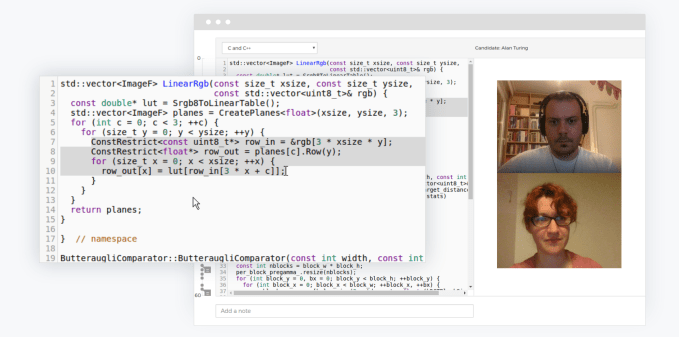
Facebook’s big opportunity here is that it’s a place people already browse naturally, so they can be exposed to Job listings even when they’re not actively looking for a company or career change. Since launching the feature in early 2017, Facebook has focused on blue-collar jobs like service and retail industry jobs that constantly need filling. But the Refdash team could give it more experience in recruiting for technical roles, connecting high-skilled workers like computer programmers to positions that need filling. These hirers might be willing to pay high prices to advertise their job listings on Facebook, siphoning revenue away from LinkedIn.
Facebook confirms that this is not an acquisition or technically a full acquihire, as there’s no overarching deal to buy assets or talent as a package. It’s so far unclear what exactly will happen to Refdash now that its team members are starting at Facebook this week, though it’s possible it will shut down now that its leaders have left for the tech giant’s cushy campuses and premium perks. Refdash’s website now says that “We’ve temporarily suspended interviews in order to make product changes that we believe will make your job search experience significantly better.”
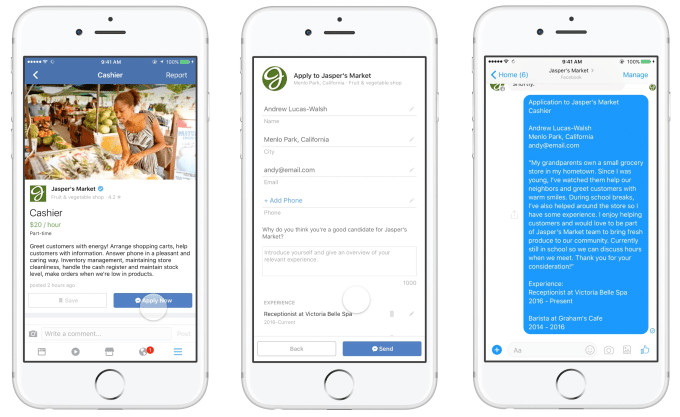
Founded in 2016 in Mountain View with an undisclosed amount of funding from Founder Friendly Labs, Refdash gave programmers direct qualitative and scored feedback on their coding interviews. Users would do a mock interview, get graded, and then have their performance anonymously shared with potential employers to match them with the right companies and positions for their skills. This saved engineers from having to endure grueling interrogations with tons of different hirers. Refdash claimed to place users at startups like Coinbase, Cruise, Lyft, and Mixpanel.
A source tells us that Refdash focused on understanding people’s deep professional expertise and sending them to the perfect employer without having to judge by superficial resumes that can introduce bias to the process. It also touted allowing hirers to browse candidates without knowing their biographical details, which could also cut down on discrimination and helps ensure privacy in the job hunting process (especially if people are still working elsewhere and are trying to be discreet in their job hunt).
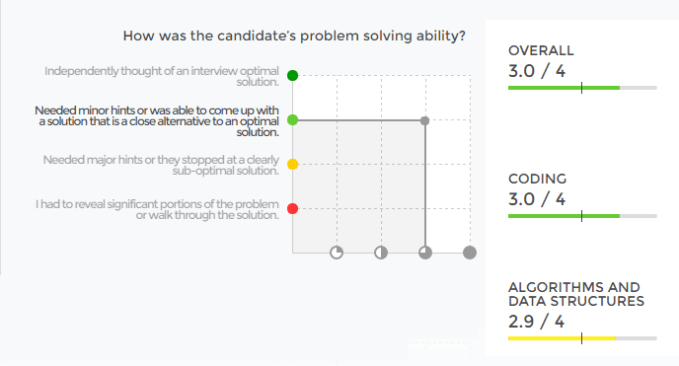
It’s easy to imagine Facebook building its own coding challenge and puzzles that programmers could take to then get paired with appropriate hirers through its Jobs product. Perhaps Facebook could even build a similar service to Refdash, though the one-on-one feedback sessions it’d conduct might not be scalable enough for Menlo Park’s liking. If Facebook can make it easier to not only apply for jobs but interview for them too, it could lure talent and advertisers away from LinkedIn to a product that’s already part of people’s daily lives.
The co-founders of Refdash have something of a track record in building companies that get acquihired to help add new features to existing services. Nicola Otasevic and Andrew Kearney were respectively the founder and tech lead for Room 77, which was picked up by Google in 2014 to help rebuild its travel search vertical. At the time it was described as a licensing deal although Refdash’s founders these days call it an acquisition.
Building tools to improve the basic process of hiring via remote testing could help Facebook get an edge on technical recruiting, but it’s not the only one building such features. LinkedIn’s stablemate Skype (like LinkedIn, owned by Microsoft) last year unveiled Interviews to let recruiters test developers and others applying for technical jobs with a real-time code editor. LinkedIn has not (yet?) incorporated it into its platform.
Powered by WPeMatico
Facebook Messenger could soon let you use your voice to dictate and send messages, initiate voice calls and create reminders. Messenger for Android’s code reveals a new M assistant button atop the message thread screen that activates listening for voice commands for those functionalities. Voice control could make Messenger simpler to use hands-free or while driving, more accessible for the vision or dexterity-impaired and, perhaps one day, easier for international users whose native languages are hard to type.
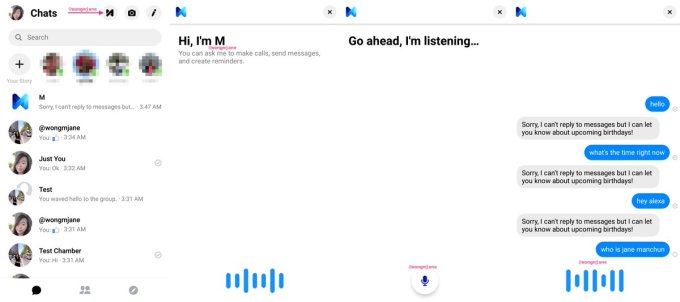
Facebook Messenger was previously spotted testing speech transcription as part of the Aloha voice assistant believed to be part of Facebook’s upcoming Portal video chat screen device. But voice commands in the M assistant are new, and demonstrate an evolution in Facebook’s strategy since its former head of Messenger David Marcus told me voice “is not something we’re actively working on right now” in September 2016 onstage at TechCrunch Disrupt.
The prototype was discovered by all-star TechCrunch tipster Jane Manchun Wong, who’d previously discovered prototypes of Instagram Video Calling, Facebook’s screen time digital well-being dashboard and Lyft’s scooter rentals before they officially launched. When reached for comment, a Facebook Messenger spokesperson confirmed to TechCrunch that Facebook is internally testing the voice command feature. They told TechCrunch, “We often experiment with new experiences on Messenger with employees. We have nothing more to share at this time.”
Messenger is eager to differentiate itself from SMS, Snapchat, Android Messages and other texting platforms. The app has aggressively adopted visual communication features like Facebook Stories, augmented reality filters and more. Wong today spotted Messenger prototyping augmented reality camera effects being rolled into the GIFs, Stickers and Emoji menu in the message composer. Facebook confirms this is now in testing with a small percentage of Messenger users.

Facebook has found that users aren’t so keen on tons of bells and whistles like prominent camera access or games getting in the way of chat, so Facebook plans to bury those more in a forthcoming simplified redesign of Messenger. But voice controls add pure utility without obstructing Messenger’s core value proposition and could end up getting users to chat more if they’re eventually rolled out.
Powered by WPeMatico